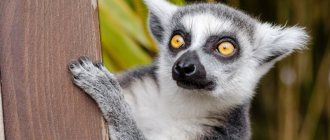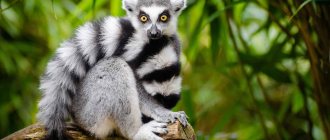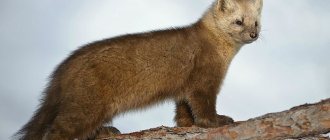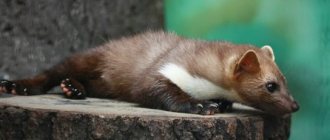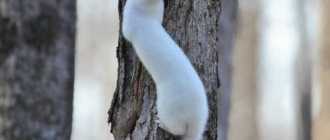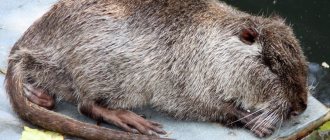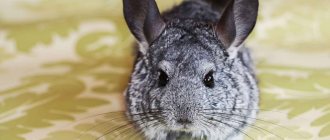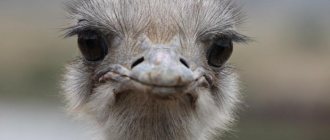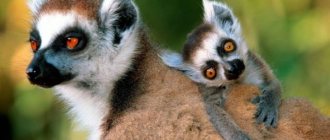In the forests of the wonderful island of Madagascar lives one of the most amazing animals in the world - the little arm, or, as it is also called, the aye-aye. This animal has such an unusual appearance that the natives of Madagascar saw in it a ghost, a fiend of hell, and in general, the source of all their troubles. Having encountered this “terrible” creature, the local population always tried to kill it. As a result of superstitions, and most importantly, due to the destruction of the animal’s habitats, the little arm was on the verge of extinction.
The Madagascar bat (Daubentonia madagascarinensis) is a mammal from the order of primates, a suborder of lemurs, the only representative of the family of bats. This animal was discovered in 1780 by Pierre Sonner, who was engaged in research in the west of Madagascar. He described this creature as a tropical rodent, but later, after long discussions, scientists nevertheless came to the consensus that the aye-aye was not a rodent at all, but a lemur, which, in the course of evolution, deviated somewhat from the general trunk of the group.
Description of the species
The Madagascar bat (Daubentonia madagascariensis) is the only living representative of the family of bats.
The creature looks unusual: brown fur, a long tail, thumbs and crazy eyes. The little hand is considered one of the large nocturnal primates. Scientists classify this species as a lemur.
Pic by Duke Lemur Center / Caters
For the inhabitants of Madagascar, these animals are sacred creatures. There are legends that whoever kills an animal will soon die himself.
The weight of the aye-aye is 3 kg, the length of the tail is 6 cm, and the entire body is 3644 cm, depending on the age of the primate. Large eyes, most often yellow, and huge ears distinguish the little monkey from other species.
It is interesting that the animal is fluffy, however, its paws are without hair. The limbs look like human hands, even have fingers. It was this fact that prevented scientists from deciding which family to assign the discovered species to.
What does aye-aye look like? Photo of the hand
The appearance of the arm is unique. The body is covered with shaggy hair of dark brown or black color; long guard hairs have white tips. The muzzle and underbody are lighter – cream or grayish. The tail is longer than the body, very fluffy. The head is quite large, round, with large, leathery, leaf-shaped ears. The large eyes are bright orange or yellow-green and surrounded by characteristic dark circles. The incisors have a structure similar to that of rodents: very sharp, constantly growing. The photo of the little arm clearly demonstrates its bizarre appearance.
The little hand is the largest representative of nocturnal primates. The body length is 36–44 cm, the tail is 45–55 cm, the weight of the animal rarely exceeds 2.5 kg.
Little arms run and jump on four limbs. The fingers and toes are equipped with long, curved claws, except for the first digit of the hind limbs, which has a real nail.
The most notable feature of the hand is the middle finger on the hand. It is incredibly long and thin and has virtually no soft tissue. The animal uses such a tool, coupled with constantly growing incisors, to obtain food: it gnaws holes in dry wood and pulls out insect larvae (photo below). This finger is also used as a drumstick to tap wood to locate the larva. Science knows of only one other mammal that uses such an unusual method of searching for food - this is the New Guinea small cuscus, which belongs to the marsupial flying squirrels.
Habitat
The species was found on the trapped island of Madagascar. Since there are very few representatives left, it is difficult to observe their behavior.
Scientists believed that the little arm lives on the west coast of the island. Most often, new populations were discovered in rain forests, where there is high humidity. They live along the entire coast in both rain and deciduous forests.
The habitat of nocturnal inhabitants is a nest made of branches and leaves, at a height of 10–15 m above the ground. The housing itself is built within 24 hours.
It was suggested that due to increased humidity, the animals retained their appearance. It is the forest area that is most suitable for the representatives. Little hands were also found in the thickets. The mangrove jungle is becoming another habitat for these creatures.
An excerpt characterizing the Madagascar crayfish
- And let's go, look! And let's go... look! - the kisser and the tall fellow repeated one after another, and both moved forward along the street together. The bloody blacksmith walked next to them. Factory workers and strangers followed them, talking and shouting. At the corner of Maroseyka, opposite a large house with locked shutters, on which was a sign of a shoemaker, stood with sad faces about twenty shoemakers, thin, exhausted people in dressing gowns and tattered tunics. - He will treat the people properly! - said a thin craftsman with a scraggly beard and frowning eyebrows. - Well, he sucked our blood - and that’s it. He drove us, drove us - all week. And now he brought it to the last end, and left. Seeing the people and the bloody man, the worker who had been speaking fell silent, and all the shoemakers, with hasty curiosity, joined the moving crowd. -Where are the people going? - It is known where, he goes to the authorities. - Well, did our power really not take over? - And you thought how! Look what the people are saying. Questions and answers were heard. The kisser, taking advantage of the increase in the crowd, fell behind the people and returned to his tavern. The tall fellow, not noticing the disappearance of his enemy the kisser, waving his bare arm, did not stop talking, thereby drawing everyone’s attention to himself. The people mostly pressed on him, expecting from him to get a solution to all the questions that occupied them. - Show him order, show him the law, that’s what the authorities are in charge of! Is that what I say, Orthodox? - said the tall fellow, smiling slightly. – He thinks, and there are no authorities? Is it possible without bosses? Otherwise, you never know how to rob them. - What nonsense to say! - responded in the crowd. - Well, then they’ll abandon Moscow! They told you to laugh, but you believed it. You never know how many of our troops are coming. So they let him in! That's what the authorities do. “Listen to what the people are saying,” they said, pointing to the tall fellow. Near the wall of China City, another small group of people surrounded a man in a frieze overcoat holding a paper in his hands. - The decree, the decree is being read! The decree is being read! - was heard in the crowd, and people rushed to the reader. A man in a frieze overcoat was reading a poster dated August 31st. When the crowd surrounded him, he seemed embarrassed, but in response to the demand of the tall fellow who had pushed ahead of him, with a slight trembling in his voice, he began to read the poster from the beginning. “Tomorrow I’m going early to the Most Serene Prince,” he read (the brightening one! - the tall fellow solemnly repeated, smiling with his mouth and frowning his eyebrows), “to talk with him, act and help the troops exterminate the villains; We too will become the spirit of them...” the reader continued and stopped (“Saw?” the little one shouted victoriously. “He will untie you all the distance...”) ... - to eradicate and send these guests to hell; I’ll come back for lunch, and we’ll get down to business, we’ll do it, we’ll finish it, and we’ll get rid of the villains.” The last words were read by the reader in complete silence. The tall fellow sadly lowered his head. It was obvious that no one understood these last words. In particular, the words: “I will come tomorrow for lunch,” apparently even upset both the reader and the listeners. The understanding of the people was in a high mood, and this was too simple and unnecessary understandable; this was the very thing that each of them could say and that therefore a decree emanating from a higher power could not speak. Everyone stood in dejected silence. The tall fellow moved his lips and staggered. “I should ask him!.. That’s what he is?.. Well, he asked!.. But then... He’ll point out...” was suddenly heard in the back rows of the crowd, and everyone’s attention turned to the droshky of the police chief, accompanied by two mounted dragoons. The police chief, who had gone that morning by order of the count to burn the barges and, on the occasion of this order, had rescued a large sum of money that was in his pocket at that moment, seeing a crowd of people moving towards him, ordered the coachman to stop. - What kind of people? - he shouted at the people, scattered and timidly approaching the droshky. - What kind of people? I'm asking you? - repeated the police chief, who did not receive an answer. “They, your honor,” said the clerk in the frieze overcoat, “they, your highness, at the announcement of the most illustrious count, without sparing their lives, wanted to serve, and not like some kind of riot, as said from the most illustrious count...” “The count did not leave, he here, and there will be orders about you,” said the police chief. - Let's go! - he said to the coachman. The crowd stopped, crowding around those who had heard what the authorities said, and looking at the droshky driving away. At that time, the police chief looked around in fear and said something to the coachman, and his horses went faster. - Cheating, guys! Lead to it yourself! - shouted the voice of a tall guy. - Don't let me go, guys! Let him submit the report! Hold it! - voices shouted, and people ran after the droshky. The crowd behind the police chief, talking noisily, headed to the Lubyanka. - Well, the gentlemen and the merchants have left, and that’s why we are lost? Well, we are dogs, or what! – was heard more often in the crowd. On the evening of September 1, after his meeting with Kutuzov, Count Rastopchin, upset and offended by the fact that he was not invited to the military council, that Kutuzov did not pay any attention to his proposal to take part in the defense of the capital, and surprised by the new look that opened up to him in the camp , in which the question of the calm of the capital and its patriotic mood turned out to be not only secondary, but completely unnecessary and insignificant - upset, offended and surprised by all this, Count Rostopchin returned to Moscow. After dinner, the count, without undressing, lay down on the sofa and at one o'clock was awakened by a courier who brought him a letter from Kutuzov. The letter said that since the troops were retreating to the Ryazan road outside Moscow, would the count like to send police officials to lead the troops through the city. This news was not news to Rostopchin. Not only from yesterday’s meeting with Kutuzov on Poklonnaya Hill, but also from the Battle of Borodino itself, when all the generals who came to Moscow unanimously said that another battle could not be fought, and when, with the count’s permission, every night government property and residents were already removing up to half let's leave - Count Rastopchin knew that Moscow would be abandoned; but nevertheless, this news, communicated in the form of a simple note with an order from Kutuzov and received at night, during his first sleep, surprised and irritated the count. Subsequently, explaining his activities during this time, Count Rostopchin wrote several times in his notes that he then had two important goals: De maintenir la tranquillite a Moscow et d'en faire partir les habitants. [Keep calm in Moscow and escort the residents out of it.] If we allow this dual goal, every action of Rostopchin turns out to be impeccable. Why were the Moscow shrine, weapons, cartridges, gunpowder, and grain supplies not taken out? Why were thousands of residents deceived by the fact that Moscow would not be surrendered and ruined? – In order to maintain calm in the capital, Count Rastopchin’s explanation answers. Why were piles of unnecessary papers removed from public places and the Leppich ball and other items? – In order to leave the city empty, Count Rastopchin’s explanation answers. One has only to admit that something threatened the people's peace, and any action becomes justified. All the horrors of terror were based only on concern for public peace. What was Count Rastopchin’s fear of public peace in Moscow based on in 1812? What reason was there for supposing there was a tendency towards indignation in the city? Residents left, troops, retreating, filled Moscow. Why should the people rebel as a result of this?
Features of behavior
As you know, the Madagascar bat is a nocturnal resident and appears only at this time of day.
It was initially assumed that representatives of this species live alone and never move in packs. After some time of observation, Elinor Sterling found out that animals can also live and feed in pairs.
Pic by Duke Lemur Center / Caters
When animals communicate, they make certain sounds that mean different actions. For example, if one of the couple wants to move to another space, he calls his companion. Most often in pairs you can see a female and a male, as well as a mother and child. The rest prefer to stay alone.
Ay-ay, they move through the trees. Only in some cases can they descend to the ground to overcome space.
Links
- [www.arkive.org/species/GES/mammals/Daubentonia_madagascariensis/ Page on www.arkive.org (photo, video)]
- [youtube.com/watch?v=CPvE_0vc3D0&search=Aye%20Aye Video on youtube.com]
- [primaty.ru/primaty/10.shtml Ay-ay]
- [lemur.su/index.php?id=86 Madagascar Aye-aye]
- [animalbox.ru/animals/aje-aje-daubentonia-madagascariensis-ili-rukonozhka-madagaskarskaya Aye-aye or Madagascar rukonozhka]. — information, photo and video materials. [www.webcitation.org/65Jo0Pf72 Archived from the original on February 9, 2012].
| There is a more complete article by Aye-aye in another language section. You can help the project by expanding the current article with translation. |
Diet
The crayfish diet includes:
- insect larvae;
- soft fruit contents;
- coconuts;
- mushrooms;
- growths on tree bark;
- fruits.
Coconut plantations are the most favorite place for animals. It is here that there is an abundance of various kinds of nuts, fruits and vegetables. Before eating a coconut, the animal knocks on it to check the amount of milk inside.
The larvae are caught in a similar way: they tap the birch bark with their middle finger and check for food. After this, the individuals gnaw through the bark, pull out the prey onto the third finger and swallow it.
The creatures also tap fruits, mushrooms and nuts in order to find out the contents, since they consume exclusively the pulp. Such a diet allows representatives of the species to be classified as omnivores.
Nutrition
The main diet of the hand-footed lemur is tropical fruits, reeds, bamboo and insects. This mammal obtains insects from the bark and cracks of trees, deftly extracting them with the help of its long and thin fingers, with which it then places larvae, beetles and other insects into its mouth.
Hard-skinned fruits are chewed in one place by their front incisors, which they grow throughout their lives, in contrast to their back canines, which fall out over time. Afterwards, through the resulting hole, using the same long fingers, they scoop out the pulp of the fruit and move it into their larynx.
With reed and bamboo the situation is approximately the same: the animal chews the upper hard layer of the plant and thus reaches the soft inside, and then, with the same long third finger, selects the edible insides and puts them in the mouth.
It has not been proven, but there is a hypothesis that the long finger on the arm is also a kind of sonar that picks up waves of various lengths from an object (tree, fruit, coconut, etc.) and with the help of which the prosimian understands whether there are insects or what is the volume of milk in a coconut? Thus, this limb is the direct organ that allows the arm to provide itself with nutrition.
Continuation of the family line
The breeding season of nocturnal creatures is not determined, but for primates this is an uncharacteristic feature. Females develop over 2-3 years, calling partners with cries. They choose a mate on the condition that the male has responded to the call, and mate with everyone who came to him.
Females do not give birth to more than one baby at a time, however, pregnancy lasts 170-172 days. For two months the baby does not leave the mother. She arranges a separate nest for him, where the child should live during this time.
Mother's milk remains the main nutrition for the little individual for the first 7 months. As it grows, the cub stays next to its mother for another 1.5 months.
Little arms, like other animals, mark territory.
- Use urine for marking.
- The cries of the creature allow you to claim ownership of the land.
- Among other things, the individuals themselves mark the territory with scent marks, and this may not always be urine.
Reproduction and lifespan
During the mating season, this species of lemur always lives in pairs. They live together and get food together. Little arms do not reproduce often; the female bears the baby for 5.5-6 months (about 170 days).
In captivity, these lemurs practically do not reproduce at all. Only one cub is always born; scientists have not noticed the appearance of twins or triplets at the same time in one couple.
The birth of a small primate occurs once every two to three years. Before the birth of the offspring, the female very carefully selects a place for the nest, building a large and cozy place with soft bedding for the birth of the baby.
The little aye-aye feeds on the female's milk for up to seven months, after which it gradually switches to feeding on its own, but still remains with its mother for some time (usually male cubs are up to one year old, females up to two).
an animal , their numbers are very small and the species is on the verge of extinction. For their breeding, special reservations are allocated where people are prohibited from entering.
In addition to all this, to preserve the population, this species is listed in the International Red Book. At the moment, no more than fifty zoos in the world have the Madagascan monkey as their pets.
Because of its unusualness and whimsicality, the little arm became very popular and was reproduced several times in cartoons. In this regard, various toys, images and pictures of little arms .
I really want to hope that through the joint efforts of inspired, caring people and zoological scientists it will be possible to preserve, and preferably increase, the population of these bizarre and interesting animals on our planet.
Threats
One of the main reasons for the extinction of the species is deforestation. Among other things, humans cause considerable harm to representatives.
Photo: Duke Lemur Center/SWNS.com
Many people believe that if they encounter a Madagascar monkey, death awaits the traveler. That is why superstitious people try to kill the animal quickly in order to avoid the curse. However, even the one who dares to kill the creature will pass away within a year.
Farmers pose a significant threat to animals. Since they feed on plantations, many people mistake them for rodents and also try to exterminate them.
Who is she - a rodent or a lemur?
The taxonomy of the Madagascar aye-aye has been repeatedly questioned: there have been long scientific debates about the place of the aye-aye in zoology. For example, its peculiar structure of teeth and squirrel tail indicated that the little arm should be classified specifically as a tropical rodent. So it was, but not for long. Scientific debate regarding the classification of this animal flared up constantly.
As a result, the scientists agreed that the Madagascar little lemur (photo No. 2) is not a rodent, but a real lemur, albeit somewhat deviated in development from the general trunk of its group. By the way, the name of the subfamily (genus) of these animals was given in honor of the French naturalist Louis Jean-Marie Daubanton, who lived in 1716-1800.
Interesting Facts
For the inhabitants of the island, the Madagascar hand-foot is an ominous prophecy, so people are afraid to pronounce the name of this animal.
In cinema, the creature was presented in the cartoon “Madagascar”. One of the representatives of the animal society of all parts is named Maurice. Also in the film "Penguins of Madagascar" the little hand became one of the main characters.
In the Malagasy language, the real name of the endangered species has never been discovered, since naming it is prohibited. In the folklore of the Malagasy there is not a single mention of the Madagascar hand-foot, also due to superstition.
What kind of animal is this?
Aye-aye, or simply aye-aye, is a mammal classified as a special species of lemur. The little hand represents the only species from the family of the same name. Nevertheless, in appearance it is completely different from either its fellow lemurs or monkeys in general. Scientists note that the Madagascan monkey (a photo of this unusual prosimian is presented in the article) is closer in its kinship to squirrels or cats. Even in its size, the animal resembles a domestic cat.
Species protection
The Madagascar bat is listed in the Red Book. Nowadays you will not find animals in forests and plantations in search of food. Most representatives of this species were transported to zoos, but only to the largest ones. Recently, a baby was born in Denver, which became a real sensation in the animal world.
The International Union for Conservation of Nature is creating all the conditions to preserve the endangered species.
At the request of representatives of the society, Madagascan arms were sent to the island of Nosy-Mangabe. Residents of the area were not allowed near the animals. The area is considered sacred, so people did not touch a single branch located there.
Notes
- ↑ 12
Gladkova T. D. Primates order // Animal life. Volume 7. Mammals / ed. V. E. Sokolova. — 2nd ed. - M.: Education, 1989. - P. 129-130. — 558 p. — ISBN 5-09-001434-5 - ↑ 12
Jolly E., Albignac R., Petter J.-J. Lemurs // Madagascar (Series: Golden Fund of the Biosphere) / trans. from English, scientific ed. B. D. Vasiliev, resp. ed. series by V. E. Sokolov. - M.: Progress, 1990. - P. 242-243. — 296 p. — ISBN 5-01-002049-1 - ↑ 12
Biological encyclopedic dictionary / Ch. ed. M. S. Gilyarov; Editorial team: A. A. Baev, G. G. Vinberg, G. A. Zavarzin, etc. - M.: Sov. encyclopedia, 1986. - P. 549. - 100,000 copies. - ↑ 1 2 3 4 Sokolov V. E.
Five-language dictionary of animal names. Mammals. Latin, Russian, English, German, French. / under the general editorship of academician. V. E. Sokolova. - M.: Rus. lang., 1984. - P. 84. - 10,000 copies. - ↑ 12
Fisher D., Simon N., Vincent D. The Red Book. Wildlife in danger / trans. from English, ed. A. G. Bannikova. - M.: Progress, 1976. - P. 50-54. — 478 p. - "Big Encyclopedia" ed. Yuzhakova, 1901-1909.
- ↑ 12
“Dictionary of modern Russian literary language” in 20 volumes, vol. 1, 1991. - "Great Soviet Encyclopedia" (3rd edition, 1969-1978), "Soviet Encyclopedic Dictionary" (1979), "Russian Spelling Dictionary" ed. V. V. Lopatina, 2001—2007 ([gramota.ru/slovari/dic/?lop=x&word=%E0%E9%E5%E0%E9%E5 online version])
- [primaty.ru/primaty/10.shtml Ay-ay]
- Bo Beolens, Michael Watkins, and Mike Grayson.
The eponym dictionary of mammals. - Baltimore: The Johns Hopkins University Press, 2009. - P. 101. - 574 p. — ISBN 978-0-8018-9304-9. - Vasiliev D. B.
Afterword // Madagascar / Rep. ed. series by V. E. Sokolov. - M.: Progress, 1990. - (Golden Fund of the Biosphere). — ISBN 5-01-002049-1.. — P. 276.
Breeding in captivity
Most aye-ayes live up to 26 years. However, there are several nature reserves where people are strictly prohibited from entering, much less feeding the animals themselves. Thanks to the proper arrangement of zoos and breeding sites, the population began to grow as natural mating occurs.
Most forest inhabitants reproduce quite rarely in captivity, although there have already been several such cases.
The animal looks quite interesting, since large eyes, a fluffy and elongated tail, as well as paws similar to human fingers, significantly distinguish them from other species.
Great article 3
